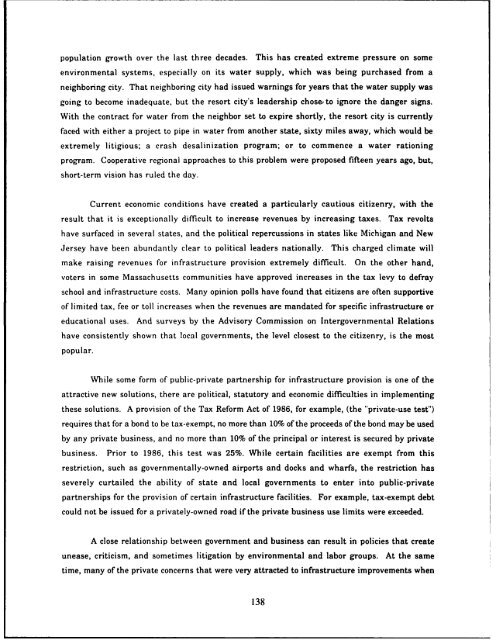Challenges and Opportunities for Innovation in the Public Works ...
Challenges and Opportunities for Innovation in the Public Works ...
Challenges and Opportunities for Innovation in the Public Works ...
You also want an ePaper? Increase the reach of your titles
YUMPU automatically turns print PDFs into web optimized ePapers that Google loves.
population growth over <strong>the</strong> last three decades. This has created extreme pressure on some<br />
environmental systems, especially on its water supply, which was be<strong>in</strong>g purchased from a<br />
neighbor<strong>in</strong>g city. That neighbor<strong>in</strong>g city had issued warn<strong>in</strong>gs <strong>for</strong> years that <strong>the</strong> water supply was<br />
go<strong>in</strong>g to become <strong>in</strong>adequate, but <strong>the</strong> resort city's leadership chose-to ignore <strong>the</strong> danger signs.<br />
With <strong>the</strong> contract <strong>for</strong> water from <strong>the</strong> neighbor set to expire shortly, <strong>the</strong> resort city is currently<br />
faced with ei<strong>the</strong>r a project to pipe <strong>in</strong> water from ano<strong>the</strong>r state, sixty miles away, which would be<br />
extremely litigious; a crash desal<strong>in</strong>ization program; or to commence a water ration<strong>in</strong>g<br />
program. Cooperative regional approaches to this problem were proposed fifteen years ago, but,<br />
short-term vision has ruled <strong>the</strong> day.<br />
Current economic conditions have created a particularly cautious citizenry, with <strong>the</strong><br />
result that it is exceptionally difficult to <strong>in</strong>crease revenues by <strong>in</strong>creas<strong>in</strong>g taxes. Tax revolts<br />
have surfaced <strong>in</strong> several states, <strong>and</strong> <strong>the</strong> political repercussions <strong>in</strong> states like Michigan <strong>and</strong> New<br />
Jersey have been abundantly clear to political leaders nationally. This charged climate will<br />
make rais<strong>in</strong>g revenues <strong>for</strong> <strong>in</strong>frastructure provision extremely difficult. On <strong>the</strong> o<strong>the</strong>r h<strong>and</strong>,<br />
voters <strong>in</strong> some Massachusetts communities have approved <strong>in</strong>creases <strong>in</strong> <strong>the</strong> tax levy to defray<br />
school <strong>and</strong> <strong>in</strong>frastructure costs. Many op<strong>in</strong>ion polls have found that citizens are often supportive<br />
of limited tax, fee or toll <strong>in</strong>creases when <strong>the</strong> revenues are m<strong>and</strong>ated <strong>for</strong> specific <strong>in</strong>frastructure or<br />
educational uses. And surveys by <strong>the</strong> Advisory Commission on Intergovernmental Relations<br />
have consistently shown that local governments, <strong>the</strong> level closest to <strong>the</strong> citizenry, is <strong>the</strong> most<br />
popular.<br />
While some <strong>for</strong>m of public-private partnership <strong>for</strong> <strong>in</strong>frastructure provision is one of <strong>the</strong><br />
attractive new solutions, <strong>the</strong>re are political, statutory <strong>and</strong> economic difficulties <strong>in</strong> implement<strong>in</strong>g<br />
<strong>the</strong>se solutions. A provision of <strong>the</strong> Tax Re<strong>for</strong>m Act of 1986, <strong>for</strong> example, (<strong>the</strong> "private-use test")<br />
requires that <strong>for</strong> a bond to be tax-exempt, no more than 10% of <strong>the</strong> proceeds of <strong>the</strong> bond may be used<br />
by any private bus<strong>in</strong>ess, <strong>and</strong> no more than 10% of <strong>the</strong> pr<strong>in</strong>cipal or <strong>in</strong>terest is secured by private<br />
bus<strong>in</strong>ess. Prior to 1986, this test was 25%. While certa<strong>in</strong> facilities are exempt from this<br />
restriction, such as governmentally-owned airports <strong>and</strong> docks <strong>and</strong> wharfs, <strong>the</strong> restriction has<br />
severely curtailed <strong>the</strong> ability of state <strong>and</strong> local governments to enter <strong>in</strong>to public-private<br />
partnerships <strong>for</strong> <strong>the</strong> provision of certa<strong>in</strong> <strong>in</strong>frastructure facilities. For example, tax-exempt debt<br />
could not be issued <strong>for</strong> a privately-owned road if <strong>the</strong> private bus<strong>in</strong>ess use limits were exceeded.<br />
A close relationship between government <strong>and</strong> bus<strong>in</strong>ess can result <strong>in</strong> policies that create<br />
unease, criticism, <strong>and</strong> sometimes litigation by environmental <strong>and</strong> labor groups. At <strong>the</strong> same<br />
time, many of <strong>the</strong> private concerns that were very attracted to <strong>in</strong>frastructure improvements when<br />
138







